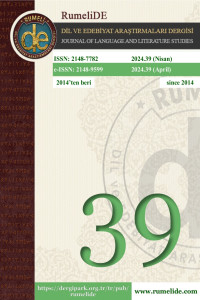Abstract
References
- Αναστασιάδη – Συμεωνίδη, Α., & Ευθυμίου, Α. (2006). Οι στερεότυπες εκφράσεις και η διδακτική της νέας ελληνικής ως δεύτερης γλώσσας, Αθήνα, Πατάκη.
- Brunel, P., Pichois Cl., & Rousseau, A. M. (1983). Τι είναι η συγκριτική γραμματολογία;. (Mτφ.σημ. Δ. Αγγελάτος). Αθήνα: Πατάκης.
- Γεωργακοπούλου, Α., & Γούτσος, Δ. (2011). Κείμενο και επικοινωνία. Αθήνα: Πατάκης. Ανανεωμένη έκδοση.
- Gibbs, R. W. (1994). The poetics of Mind: Figurative Thought, Language and Understanding. New York: Cambridge University Press.
- Hatch, A. J. (2002). Doing Qualitative Research in Education Settings. Albany: State University of York Press.
- Jakobson, R. (1959). On Linguistic Aspects of Translation. Harvard University Press: Cambridge, Massachusetts.
- Katan, D. (1999). Translating Cultures. An Introduction for Translators, Interpreters and Mediators. Manchester: St. Jerome.
- Kramsch, C. (1998). Language and Culture. Oxford: Oxford University Press.
- Lakoff, G., & Johnson, M. (1980). Metaphors We Live By. Kadıköy İstanbul: İthaki Yayınları, çev. Gökhan Yavuz Demir.
- Mogorrón, H. P. (2008). Comprehension and translation of idioms, Meta 2008, Volume 53, number2, 378-406.
- Nayak, N. P., & Gibbs, R. W. (1990). Conceptual knowledge in the interpretation of idioms. Journal of Experimental Psychology: General, 119(3), 315–330.
- Newmark, P. (1988). A Textbook of Translation. Hertfordshire: Prentice Hall.
- Türkben, T. (2015). Anlam Bilim Açısından Geçmişten Günümüze Kadar ‘Gök’ Kavramının Anlamsal Yolculuğu. Uluslararası Türk Eğitim Bilimleri Dergisi, 2015 (5), 265-272. Retrieved from https://dergipark.org.tr/tr/pub/goputeb/issue/34517/385017
Abstract
Linguists have been studying the effect of cultural elements on the challenges of second language acquisition for the last three decades. The research findings have thus far shown the significance of the close relationship between cultural context and language, as well as of the awareness of cultural factors. It is required to have available data on the cultural similarities and differences that characterize language use in languages in question and to build a discussion of the topic on a more concrete basis through research in this field to see the effect of cultural awareness on second language acquisition. Therefore, the aim of the present study is to contribute accordingly. The study's sample consists of color-related phrases from Turkish and Greek literary texts. These phrases can facilitate language acquisition by developing a cultural 'affinity' for people learning Turkish and Greek. The present study is centered on the linguistic aspects of the Turkish and Greek societies, which have had long-standing relationships, and aims to determine where these two language communities differ or share similarities. Quantitative, qualitative and content analysis methods were used in this study. To clarify, the quantitative component is the frequency with which the relevant lexical units occur, whereas the qualitative aspect is the similarities and differences that emerge from the analyses of specific expressions operationalized for the purpose of the study.
References
- Αναστασιάδη – Συμεωνίδη, Α., & Ευθυμίου, Α. (2006). Οι στερεότυπες εκφράσεις και η διδακτική της νέας ελληνικής ως δεύτερης γλώσσας, Αθήνα, Πατάκη.
- Brunel, P., Pichois Cl., & Rousseau, A. M. (1983). Τι είναι η συγκριτική γραμματολογία;. (Mτφ.σημ. Δ. Αγγελάτος). Αθήνα: Πατάκης.
- Γεωργακοπούλου, Α., & Γούτσος, Δ. (2011). Κείμενο και επικοινωνία. Αθήνα: Πατάκης. Ανανεωμένη έκδοση.
- Gibbs, R. W. (1994). The poetics of Mind: Figurative Thought, Language and Understanding. New York: Cambridge University Press.
- Hatch, A. J. (2002). Doing Qualitative Research in Education Settings. Albany: State University of York Press.
- Jakobson, R. (1959). On Linguistic Aspects of Translation. Harvard University Press: Cambridge, Massachusetts.
- Katan, D. (1999). Translating Cultures. An Introduction for Translators, Interpreters and Mediators. Manchester: St. Jerome.
- Kramsch, C. (1998). Language and Culture. Oxford: Oxford University Press.
- Lakoff, G., & Johnson, M. (1980). Metaphors We Live By. Kadıköy İstanbul: İthaki Yayınları, çev. Gökhan Yavuz Demir.
- Mogorrón, H. P. (2008). Comprehension and translation of idioms, Meta 2008, Volume 53, number2, 378-406.
- Nayak, N. P., & Gibbs, R. W. (1990). Conceptual knowledge in the interpretation of idioms. Journal of Experimental Psychology: General, 119(3), 315–330.
- Newmark, P. (1988). A Textbook of Translation. Hertfordshire: Prentice Hall.
- Türkben, T. (2015). Anlam Bilim Açısından Geçmişten Günümüze Kadar ‘Gök’ Kavramının Anlamsal Yolculuğu. Uluslararası Türk Eğitim Bilimleri Dergisi, 2015 (5), 265-272. Retrieved from https://dergipark.org.tr/tr/pub/goputeb/issue/34517/385017
Details
| Primary Language | English |
|---|---|
| Subjects | Comparative Language Studies |
| Journal Section | Turkish language, culture and literature |
| Authors | |
| Publication Date | April 21, 2024 |
| Submission Date | February 27, 2024 |
| Acceptance Date | April 20, 2024 |
| Published in Issue | Year 2024 Issue: 39 |


